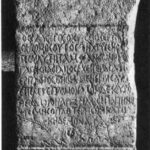| Artefact ID | 1315 |
| TM ID | TM 88334 |
| Findspot (DEChriM ID) | 23 (al-Šayḫ ʿIbāda) | Class | Textual |
| Material | Stone |
| Writing medium | Inscription |
| Text content | Subliterary |
| Language | Greek |
| Description | I.Métriques 123; IGChrEg 227; SEG LI 2127 descr.; SEG XXXIV 1553 descr.: Honorary epigram for Fl. Ulpius Erythrius, governor of Thebais. Tall limestone base with mouldings at top and bottom: H. 125, W 60, D 60 cm. The text contains three elegiac distichs, set over nine lines. This verse celebrates the golden (gilded) statue which the governor (praeses Thebaidos) Erythrius received as an imperial reward for his good governorship. The last distich mentions, in a reference to the noble family of Erythrius, his father-in-law Theodorus who held office as urban prefect of Constantinople. Below the inscription is a cross, within a wreath, from which emanate two sinuous bands, and which is flanked by two palm branches. |
| Selection criteria | Christian symbols/gestures/isopsephy |
| Date from | 385 |
| Date to | 387 |
| Dating criteria | Prosopography (SEG LI 2127). |
| Absolute/relative date | Absolute date |
| Archaeological context | The base was recorded in the village of Mellaoui el-Arich on the west bank of the Nile in 1885 by A.H. Sayce, who was told that it came from Antinoopolis. However, it was recorded to come from the village of Reiramoun, likewise on the west bank (6 km south of Antinoopolis), by the Museum-journals (Bernand 1969, 489 with n. 1). |
| Accession number | Cairo, Egyptian Museum CG 9290 / JdE 29876. |


 Json data
Json data




